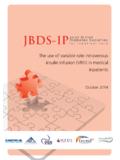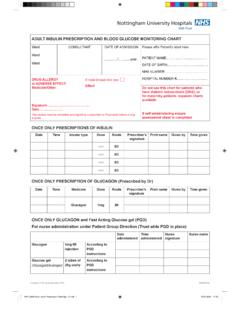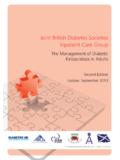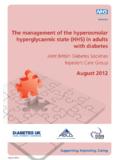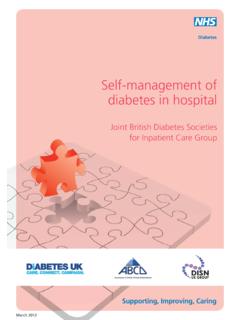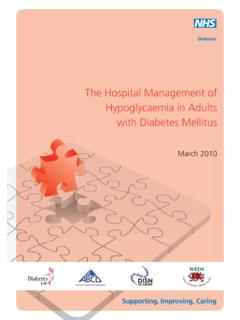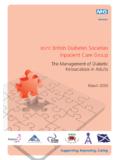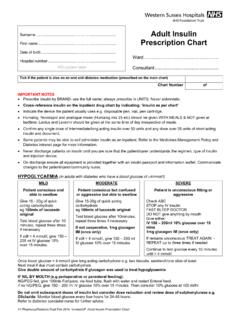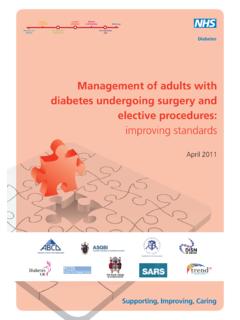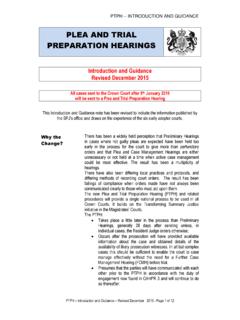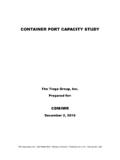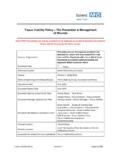Transcription of Joint British Diabetes Societies (JBDS) for inpatient care
1 glycaemic management during theinpatient enteral feeding of strokepatients with diabetesJoint British Diabetes Societies (JBDS) for inpatient careJune 2012 Supporting, Improving, CaringJune 2012 This document is coded JBDS 05 in the series of JBDS documents:Self- management of Diabetes in Hospital March 2012 JBDS 04 The management of Adults with Diabetes undergoing Surgery and Elective Procedures: improvingstandards April 2011 JBDS 03 The Hospital management of Diabetic Ketoacidosis in Adults March 2010 JBDS 02 The Hospital management of Hypoglycaemia in Adults with Diabetes Mellitus March 2010 JBDS 01 All of these publications can be found on the NHS Diabetes website at management during the inpatient enteral feeding of stroke patients with Diabetes Authorship - Writing and review group6 summary of recommendations8 Introduction10 Nursing a patient on the ward with an enteral feed12 Commencing NG feeding in a person with elevated blood glucose 13 Blood glucose targets14 Frequency of bedside glucose monitoring15 management of blood glucose16 Choice of agent to achieve glucose control17 Subcutaneous Insulin.
2 Options17 Actions to undertake if feed stopped20 Actions in event of hyperglycaemia20 Actions to avoid in event of hyperglycaemia20 Actions in event of hypoglycaemia21 Areas of Uncertainty23 Appendix 124 Available insulins and guidelines for appropriate useAppendix 225 Calculating the insulin dose according to a weight based equationAppendix 326 Example of a locally used individual protocol for starting enteral feed and titration of intravenousinsulin in type 2 management during the inpatient enteral feeding of stroke patients withdiabetes A diagnosis of Diabetes at least doubles the risk of stroke1. Thus a considerable proportion of patientspresenting to hospital with acute stroke will have type 2 Diabetes , and less commonly type 1 Diabetes . An estimated 150,000 people suffer a stroke in the UK every year2, occupying around 20 per cent of allacute hospital beds and 25 per cent of long term beds3.
3 A standard approach to the management ofpatients with stroke is the provision of adequate nutrition. Frequently this involves a period of enteralfeeding should the stroke have resulted in an impaired ability to swallow food safely. There is currently considerable variability in the management of Diabetes inpatients fed enterally followinga stroke. Variation in the inpatient management of hyperglycaemia and hypoglycaemia in people receivingenteral feeding following stroke may worsen patient recovery and the potential for aim of this document is to provide guidance to multidisciplinary teams (MDT) general physicians andstroke specialists, general medical ward and stroke unit nursing staff, dietitians and nutrition teams. Itaims to provide pragmatic guidance for the inpatient management of people with stroke who havediabetes and who require a period of enteral feeding in order to improve patient outcomes and document has been produced by the Joint British Diabetes Societies for inpatient Care (JBDS IP) onbehalf of Diabetes UK, the Association of British Clinical Diabetologists (ABCD), and the DiabetesInpatient Specialist Nurse (DISN) UK Group, in collaboration with NHS Diabetes and the Primary CareDiabetes Society (PCDS).
4 This document is produced from a review of the limited available clinical evidence in this area togetherwith the input of a working group of clinical staff with expertise in Diabetes , enteral feeding and strokemedicine. It has sought input from Diabetes nurses, diabetologists, dietitians, stroke physicians andpharmacists throughout the United Kingdom. 6 Authorship - writing and review groupsLead authorshipDr Aled Roberts, Cardiff and Vale University Local Health BoardSimone Penfold, The Royal Bournemouth and Christchurch Hospitals NHS Foundation TrustSupporting organisationsJill Hill (Birmingham), TREND UKTracy Kelly, Diabetes UKProfessor Mike Sampson (Norwich), Joint British Diabetes Societies (JBDS) inpatient Care Group ChairEsther Walden (Norwich), Diabetes inpatient Specialist Nurse (DISN) UK Group ChairDr Chris Walton (Hull), Association of British Clinical Diabetologists (ABCD)
5 ChairWriting groupSiobhan Ashton-Cleary, Derby Hospitals NHS Foundation TrustDr Moulinath Banerjee, University Hospitals of Morecambe Bay NHS Foundation TrustHannah Berkeley, University Hospitals of Leicester NHS Trust Caroline Brooks, Maidstone and Tunbridge Wells NHS TrustDanielle Bruce, University Hospitals of Leicester NHS TrustDr Ketan Dhatariya, Norfolk and Norwich University Hospitals NHS Foundation TrustLaura Dinning, Harrogate and District NHS Foundation TrustBeverley Eaglesfield, Derby Hospitals NHS Foundation TrustSarah Gregory, East Kent Hospitals University NHS Foundation TrustDr Tom Hughes, Cardiff and Vale University Local Health BoardDr Partha Kar, Portsmouth Hospitals NHS TrustDr Samson Oyibo, Peterborough and Stamford Hospitals NHS Foundation TrustSian Rilstone, Wye Valley NHS TrustNicola Robinson, Brighton and Sussex University Hospitals NHS TrustProfessor Alan Sinclair, Luton & Dunstable Hospital NHS Foundation Trust and Dean of Beds and HertsPostgraduate Medical SchoolDebbie Voigt, NHS TaysideLara Wessels, St Helens and Knowsley Teaching Hospital NHS TrustJoy Williams, Western Sussex Hospitals NHS TrustLindsay Oliver and Helen Davies (The Diabetes management & Education Group of The British DieteticAssociation)Siobhan Hughes (Parenteral and Enteral Nutrition Group of the British Dietetic Association)Natasha Jacques (UK Clinical Pharmacy Association)
6 University Hospitals of Leicester Dietitians7 JBDS IP Review GroupDr Belinda Allan, Hull and East Yorks Hospital NHS TrustDr Daniel Flanagan, Plymouth Hospitals NHS TrustDr Maggie Hammersley, Oxford University Hospitals NHS TrustDr Rowan Hillson, MBE, National Clinical Director for DiabetesJune James, University Hospitals of Leicester NHS TrustDr Johnny McKnight, NHS LothianDr Rif Malik, King s College Hospital NHS Foundation TrustDr Gerry Rayman, The Ipswich Hospitals NHS TrustDr Kate Richie, Southern Health and Social Care Trust, Northern IrelandProfessor Mike Sampson (Norwich) Joint British Diabetes Societies (JBDS) inpatient Care Group ChairDr Mark Savage, The Pennine Acute Hospitals NHS TrustDr Adrian Scott, Sheffield Teaching Hospitals NHS Foundation TrustDebbie Stanisstreet, East and North Hertfordshire NHS TrustDr Louise Stuart, The Pennine Acute Hospitals NHS TrustDr Jonny Thow, York Teaching Hospital NHS Foundation TrustEsther Walden, Norfolk and Norwich University Hospitals NHS Foundation TrustDr Chris Walton, Hull and East Yorks Hospital NHS TrustDr Peter Winocour, East and North Hertfordshire NHS TrustWith special thanks to Christine Jones (DISN UK Group administrator, Norwich)
7 For her administrative workand help with these guidelines and with JBDS of acronymsNGT nasogastric tubePEG - percutaneous endoscopicgastrostomyDISN Diabetes inpatientspecialist nurseVRIII variable rate intravenousinsulin infusionDKA diabetic ketoacidosisDIT - Diabetes inpatient teamFRIII - fixed rate intravenousinsulin infusionNPSA - National Patient SafetyAgencyJBDS Joint British DiabetesSocietiesCBG capillary blood glucoseCSIII- continuous subcutaneousinsulin infusionT2DM type 2 Diabetes mellitusNPH neutral protaminehagedornGLP-1- glucagon like peptide-1mimeticsT1DM type 1 Diabetes mellitusSummary of recommendations 4-6 hourly capillary blood glucose (CBG) monitoring of all patients presenting with stroke and Diabetes ornewly recognised hyperglycaemia.
8 Refer patient to Diabetes inpatient specialist nurse (DISN)/ Diabetes inpatient team (DIT) at earliest opportunityfor individual assessment. Patients with type 1 Diabetes should continue their basal insulin at all times whether receiving insulin via thesubcutaneous or intravenous route and should not have insulin omitted. Continue subcutaneous basal analogue insulin (Glargine or Detemir) if patient treated with basal analogueinsulin on admission. Target CBG 6-12 mmol/l during enteral feeding of people with Diabetes . Early involvement of a dietitian to determine an appropriate feed regimen. Aim to minimise use of intravenous insulin infusions as far as possible aim to establish patient on tosubcutaneous insulin or glucose-lowering agents administered via the nasogastric tube (NGT) at the earliestopportunity.
9 Premixed human insulin at start and midpoint of feed, or isophane insulin at start and, if necessary, themidpoint of feed are recommended first line options for glycaemic management of patients with poorlycontrolled type 2 Diabetes during enteral feeding. Administration of soluble human insulin at the time of feed commencement is recommended for a bolusfeeding regimen. For those patients prescribed Glargine or Detemir on admission to hospital and receivingcontinuous feeding with CBG>12 mmol/l, soluble human insulin may be administered at the start and, ifnecessary, midpoint of the feed. Resuspension of metformin powder administered via NGT may be useful as a sole treatment, or adjunct, forpeople with type 2 Diabetes . Crushing of oral tablet medications for administration via NGT is not recommended.
10 Monitor capillary glucose pre-feed and then 4-6 hourly when feed running; monitor hourly if feedunexpectedly switched off. Involve DISN/DIT immediately in event of hypoglycaemia or recurrent for the management of hyperglycaemia during enteral feeding of strokepatients with Diabetes JBDS guideline Diagnosis of strokeMeasure capillary blood glucose (CBG) on admission and during first 24 hours ofinpatient stayIf CBG persistently elevated (>7 mmol/l) does patient already have diagnosis of Diabetes ?If so type 2 or type 1 Diabetes ? If unsure refer to DISN/DIT for insulin passport and medication on decision to feed via NGTD ietitian to prescribe appropriate feed regimen for patientRefer to DIT/DISN at earliest opportunityPatient with type 1 diabetesContinue Glargine/Detemir in bolus doses of soluble or rapidacting insulin at start, 6 and 12 hours intofeed as DISN/DIT at earliest unnecessary use of patient on continuous subcutaneousinsulin pump this should be stopped andsubcutaneous insulin with well-controlled type 2diabetes (CBG 6 12 mmol/l)Consider metformin powder resuspended and administered viaNGT if CBG rising >12 mmol/lduring feed regimen.
